1997 PONTIAC BONNEVILLE light
[x] Cancel search: lightPage 266 of 405
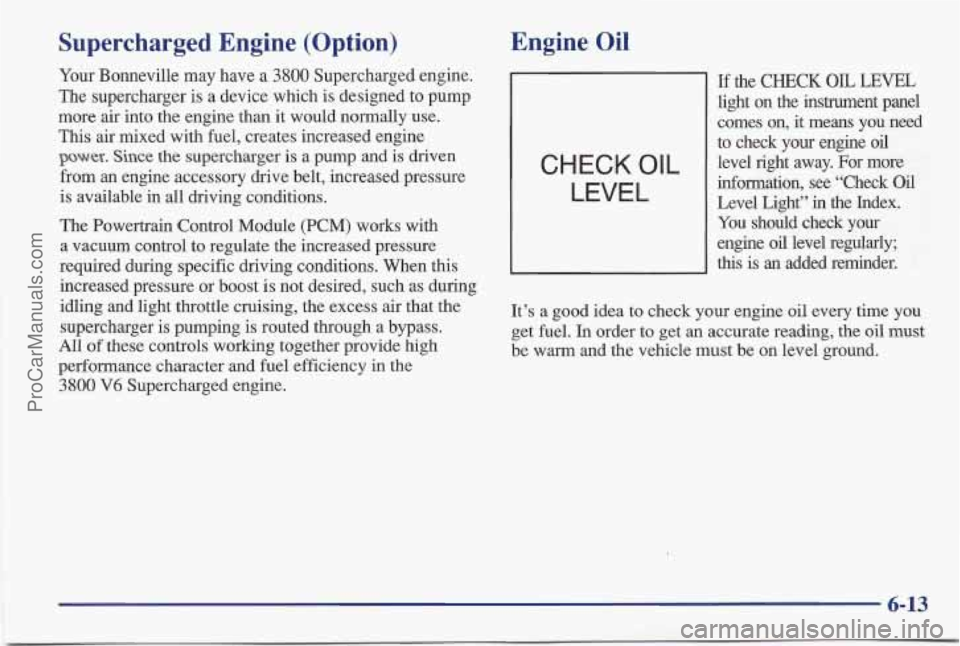
Supercharged Engine (Option)
Your Bonneville may have a 3800 Supercharged engine.
The supercharger is a device which is designed to pump
more air into the engine than
it would normally use.
This air mixed with fuel, creates increased engine
power. Since the supercharger is a pump and is driven
from an engine accessory drive belt, increased pressure
is available in all driving conditions.
The Powertrain Control Module (PCM) works with
a vacuum control to regulate the increased pressure
required during specific driving conditions. When this
increased pressure or boost
is not desired, such as during
idling and light throttle cruising, the excess air that the
supercharger is pumping is routed through a bypass.
AI1 of these controls working together provide high
performance character and fuel efficiency in the
3800 V6 Supercharged engine.
Engine Oil
CHECK OIL
LEVEL
If the CHECK OIL LEVEL
light on the instrument panel
comes on, it means you need
to check your engine
oil
level right away. For more
information, see “Check
Oil
Level Light’’ in the Index.
You should check your
engine
oil level regularly;
this is
an added rerninder.
It’s a good idea to check your engine oil every time you
get
fuel. In order to get an accurate reading, the oil must
be warm and the vehicle must be on level ground.
6-13
ProCarManuals.com
Page 277 of 405
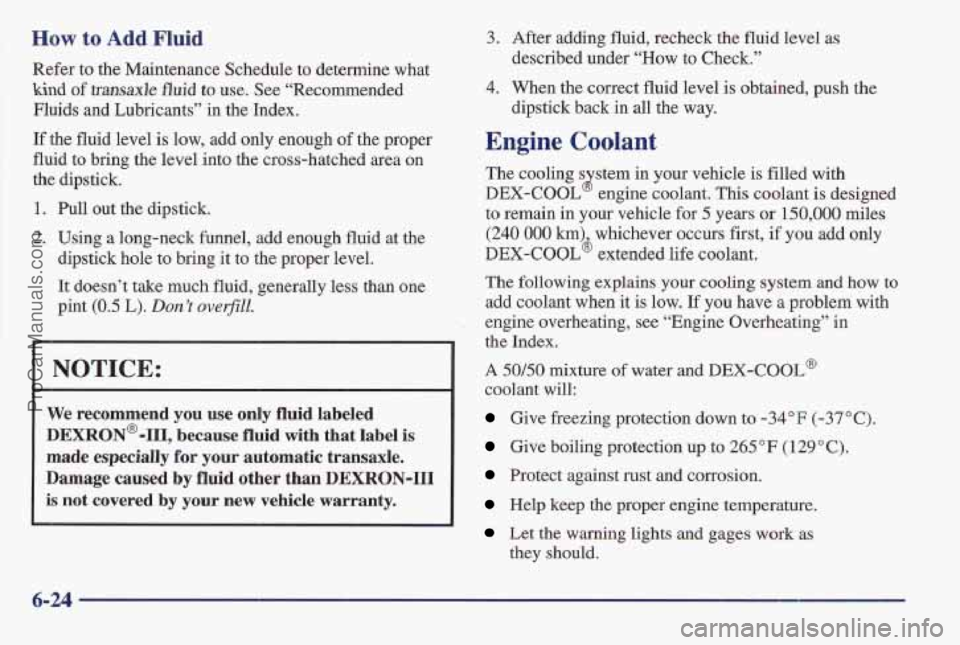
How to Add Fluid
Refer to the Maintenance Schedule to determine what
kind of transaxle fluid to use. See “Recommended
Fluids and Lubricants” in the Index.
If
the fluid level is low, add only enough of the proper
fluid to bring the level into the cross-hatched area on
the dipstick.
1. Pull out the dipstick.
2. Using a long-neck funnel, add enough fluid ,. @e
dipstick hole to bring it to’ the proper level.
It doesn’t take much fluid, generally less than one
pint
(0.5 L). Don’t overjU.
NOTICE:
We recommend you use only fluid labeled
DEXRON@-111, because fluid with that label i,s
made especially for your automatic transaxle.
Damage caused by fluid other than DEXRON-I11
is not covered by your new vehicle warranty.
3. After adding fluid, recheck the fluid level as
described under “How to Check.”
4. When the correct fluid level is obtained, push the
dipstick back in all the way.
Engine Coolant
The cooling s stem in your vehicle is filled with
DEX-COOL engine coolant. This coolant is designed
to remain in your vehicle for
5 years or 150,000 miles
(240 000 km) whichever occurs first, if you add only
DEX-COOL6 extended life coolant.
The following explains your cooling system and how to
add coolant when it is low. If you have ;e problem with
engine overheating, see “Engine Overheating” in
the
Index.
A 50J50 mixture of water and DEX-COOL@
coolant will:
Give freezing protection down to -34°F (-37°C).
Give boiling protection up to 2685 “F (129 O C).
Protect against rust and corrosion.
Help keep the proper engine temperature.
Llet the warning lights and gages work as
8
they should.
6-24
ProCarManuals.com
Page 280 of 405
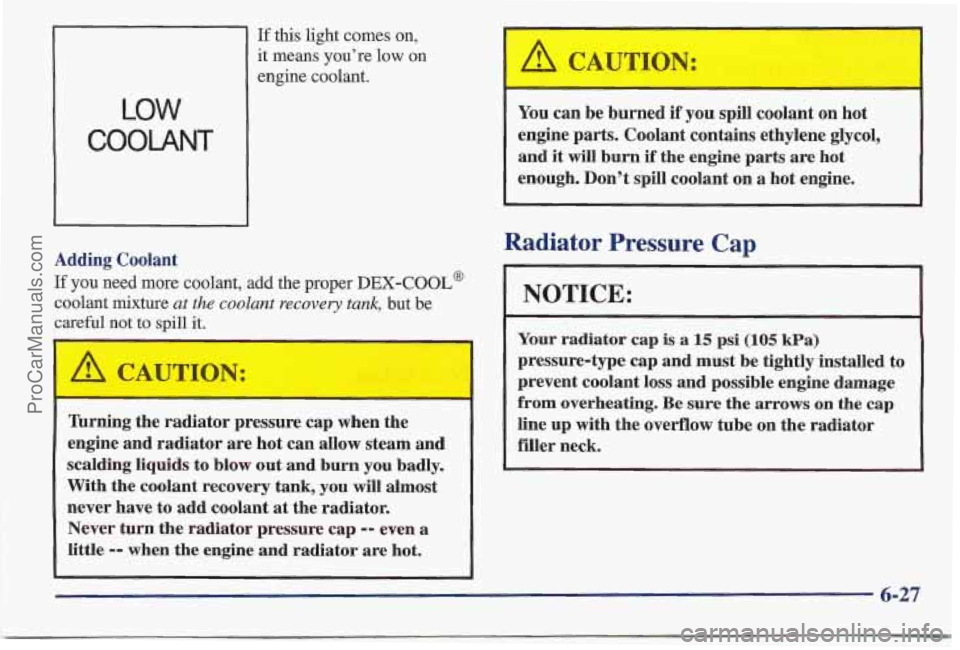
If this light comes on,
it means you’re low on
LOW
COOLANT
engine coolant.
Adding Coolant
If you need more coolant, add the proper DEX-COOL@
coolant mixture at the coolant recovery tank, but be
careful not to spill
it.
Turning the radiator pressure cap when the
engine and radiator are hot can allow steam and
scalding liquids to blow out and burn you badly.
With the coolant recovery tank, you will almost
never have to add coolant
at the radiator.
Never turn the radiator pressure cap
-- even a
little
-- when the engine and radiator are hot. You
can be
burned if you spill coolant on hot
engine parts. Coolant contains ethylene glycol,
and it will burn
if the engine parts are hot
enough. Don’t spill coolant on a hot engine.
Radiator Pressure Cap
NOTICE:
Your radiator cap is a 15 psi (105 kPa)
pressure-type cap and must be tightly installed to
prevent coolant loss and possible engine damage
from overheating. Be sure the arrows on the cap
line up with the overflow tube on the radiator
filler neck.
6-27
ProCarManuals.com
Page 283 of 405

Brakes
Brake Fluid
Your brake master cylinder reservoir is here. It is filled
with
DOT-3 brake fluid.
There
are only two reasons why the brake fluid level in
the reservoir might go down. The first is that the brake
fluid goes down to an acceptable level during normal
brake lining wear. When
new linings are put in, the fluid
level goes
back up. The other reason is that fluid is
leaking out of the brake system.
If it is, you should have your brake
system fixed,
since a leak means that sooner
or later your brakes won’t work well, or won’t work
at all,
So, it isn’t a good idea to “top off’ your brake fluid.
Adding brake fluid won’t correct a leak. If you add fluid
when your linings are worn, then you’ll have too much
fluid when
you get new brake linings. You should add
(or remove) brake fluid, as necessary, only when w’ork is
done on the brake hydraulic system.
If you have too much brake fluid, it can spill
on the engine. The fluid will burn if the engine
is hot enough. You or others could be burned,
and
your vehicle could be damaged. Add brake
fluid only when work is done on the brake
hydraulic system,
When your brake fluid falls to a low level, your brake
warning light will come
on. A chime will sound if you
try to drive with this warning light on. See “Brake
System
Wming Light” in the Index.
6-30
ProCarManuals.com
Page 285 of 405
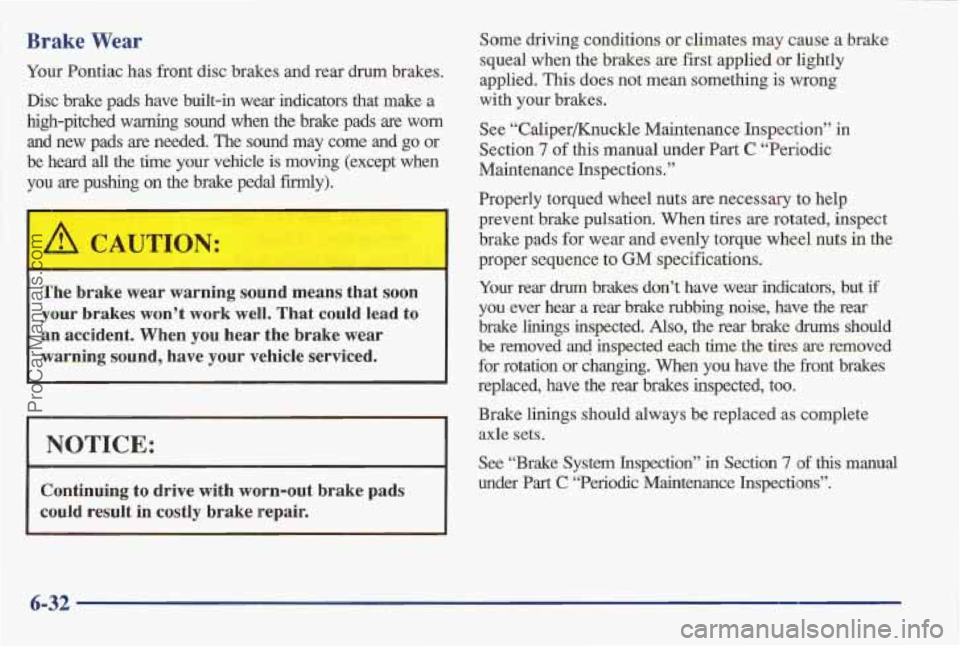
Brake Wear
Your Pontiac has front disc brakes and rear drum brakes.
Disc brake pads have built-in wear indicators that make
a
high-pitched warning sound when the brake pads are worn
and new pads are needed. The
sound may come and go or
be heard all the time your vehicle is moving (except when
you are pushing on the brake pedal fiiy).
Le brake wear warning sound means that soon
your brakes won’t work well. That could lead to
an accident. When you hear the brake wear
warning sound, have
your vehicle serviced.
I NOTICE:
Continuing to drive with worn-out brake pads
could
result in costly brake repair.
Some driving conditions or climates may cause a brake
squeal when the brakes are first applied or lightly
applied. This does not mean something
is wrong
with your brakes.
See “Caliper/Knuckle Maintenance Inspection” in
Section
7 of this manual under Part C “Periodic
Maintenance Inspections.”
Properly torqued wheel nuts are necessary to help
prevent brake pulsation. When tires are rotated, inspect
brake pads for wear
and evenly torque wheel nuts in the
proper sequence to
GM specifications.
Your rear drum brakes don’t have wear indicators, but if
you ever hear a rear brake rubbing noise, have the rear
brake linings inspected.
Also, the rear brake drums should
be removed
and inspected each time the tires are removed
for rotation or changing. When you have the front brakes
replaced, have the rear brakes inspected, too.
Brake linings
should always be replaced as complete
axle sets.
See “Brake System Inspection”
in Section 7 of this manual
under Part
C 44Periodic Maintenance Inspections”.
6-32
ProCarManuals.com
Page 300 of 405

Uniform Tire Quality Grading
The following information relates to the system
developed by the United States National Highway
Traffic Safety Administration, which grades tires by
treadwear, traction and temperature performance. (This
appLies
only to vehicles sold in the United States.) The
grades are molded on the sidewalls
of most passenger
car tires. The Uniform Tire Quality Grading system
does not apply to deep tread, winter-type snow tires,
space-saver or temporary use spare tires, tires with
nominal rim diameters
of 10 to 12 inches (25 to 30 cm),
or to some limited-production tires.
While the tires available on General Motors passenger
cars and light trucks may vary with respect to these
grades, they must also conform to Federal safety
requirements and additional General Motors Tire
Performance Criteria (TPC) standards.
Treadwear
The treadwear grade is a comparative rating based on
the wear rate
of the tire when tested under controlled
conditions on a specified government test course. For
example, a tire graded 150 would wear one and a half
(1
1/2) times as well on the government course as a tire
graded
100. The relative performance of tires depends
upon the actual conditions
of their use, however, and
may depart significantly from the norm due to variations
in driving habits, service practices and differences in
road characteristics and climate.
Traction -- A, B, C
The traction grades, from highest to lowest, are A, B, and
C, and they represent the tire’s ability to stop on wet
pavement as measured under controlled conditions on
specified government test surfaces of asphalt and concrete.
A tire marked C may have poor traction performance.
Warning: The traction grade assigned to this tire is based
on braking (straightahead) traction tests and does not
include cornering (turning) traction.
6-47
ProCarManuals.com
Page 304 of 405

Cleaning the Inside of Your Pontiac
Use a vacuum cleaner often to get rid of dust and loose
dirt. Wipe vinyl or leather with a clean, damp cloth.
Your Pontiac dealer has two cleaners, a solvent-type
spot lifter and a foam-type powdered cleaner. They will clean normal spots and stains very well.
Do not use
them on vinyl
or leather.
Here are some cleaning tips:
1. Always read the instructions on the cleaner label.
2. Clean up stains as soon as you can -- before they set.
3. Use a clean cloth or sponge, and change to a clean area
often.
A soft brush may be used if stains are stubborn.
4. Use solvent-type cleaners in a well-ventilated area
5. If a ring forms after spot cleaning, clean the entire
only. If you
use them, don’t saturate the stained area.
area immediately or
it will set.
Using Foam-Type Cleaner on Fabric
1. Vacuum and brush the area to remove any loose dirt.
2. Always clean a whole trim panel or section. Mask
3. Mix Multi-Purpose Powdered Cleaner following the
surrounding trim along
stitch or welt lines.
directions
on the container label.
4.
5.
6.
7.
8.
9.
Use suds only and apply with a clean sponge. Don’t
saturate the material and don’t rub it roughly.
As soon as you’ve cleaned the section, use a sponge
to remove the suds.
Rinse the section with a clean, wet sponge.
Wipe off what’s left with a slightly damp paper towel
or cloth.
Dry it immediately with a blow dryer.
Wipe with a clean cloth.
Using Solvent-Type Cleaner on Fabric
First, see if you have to use solvent-type cleaner at all.
Some spots and stains will clean off better with just
water
and mild soap.
If you need to use a solvent:
1.
2.
3.
4.
Gently scrape excess soil from the trim material with
a clean, dull knife or scraper.
Use very little cleaner, light pressure and clean cloths
(preferably cheesecloth). Cleaning should start at the
outside of the stain, “feathering” toward the center.
Keep changing to a clean section
of the cloth.
When you clean a stain from fabric, immediately
dry the
area with a blow dryer to help prevent a cleaning ring.
6-51
ProCarManuals.com
Page 305 of 405
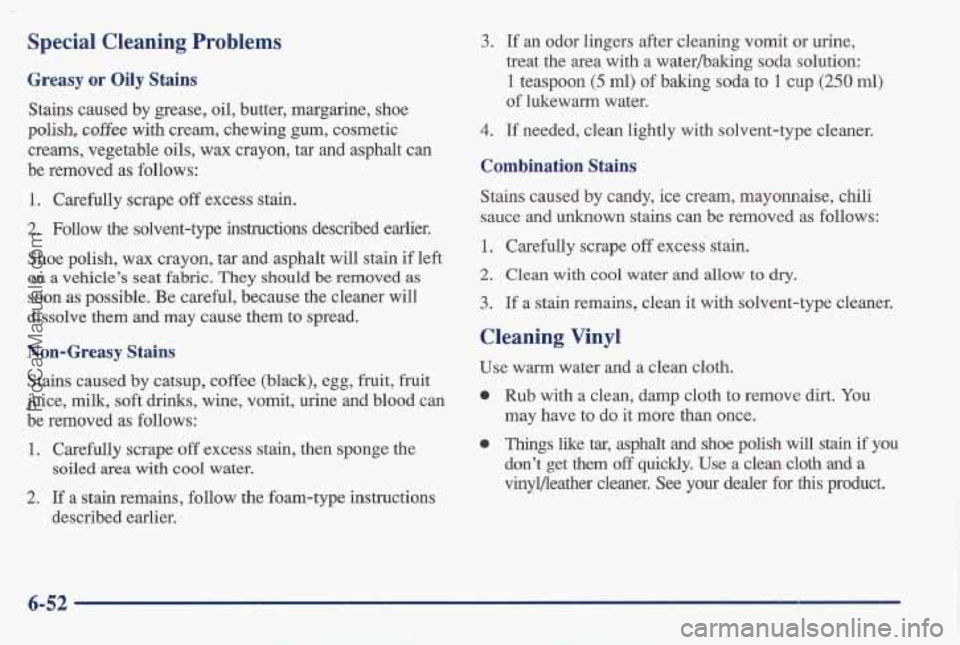
Special Cleaning Problems
Greasy or Oily Stains
Stains caused by grease, oil, butter, margarine, shoe
polish,
coffee with cream, chewing gum, cosmetic
creams, vegetable oils, wax crayon, tar and asphalt can
be removed as follows:
1. Carefully scrape off excess stain.
2, Follow the solvent-type instructions described earlier.
Shoe polish, wax crayon, tar and asphalt will stain if left
on a vehicle's seat fabric. They should be removed
as
soon as possible. Be careful, because the cleaner will
dissolve
them and may cause them to spread.
Non-Greas'y Stains
Stains caused by catsup, coffee (black), egg, hit, fruit
juice, milk, soft drinks, wine,
vomit, urine and blood can
be removed as follows:
1. Casefully scrape off excess stain, then sponge th'e
soiled area with cool water.
2. If a stain remains, follow the foam-type instructions
described earlier.
.
3. If an odor lingers after cleaning vomit or urine,
treat
the area with a waterbaking soda solution:
1 teaspoon (5 ml) of baking soda to 1 cup (250 ml)
of lukewarm water.
4. If needed, clean lightly with solvent-type cleaner.
Combination Stains
Stains caused by candy, ice cream, mayonnaise, chili
sauce and unknown stains can
be removed as follows:
1. Carefully scrape off excess stain.
2. Clean with cool water and allow to dry.
3. If a stain remains, clean it with solvent-type cleaner.
Cleaning Vinyl
Use warm water and a clean cloth.
e Rub with a clean, damp cloth to remove dirt. You
may have
to do it more than once.
e Things like tar, asphalt and shoe polish will stain if you
don't get
them off quickly. Use a clean cloth and a
vinymeather cleaner. See your dealer for this product.
6-52
ProCarManuals.com